A number of Legumes (Fabaceae) have been introduced to Laos for their ornamental value. The Saman, native to South America, was first planted in the region, Petelot tells us, in 1875 at the Saigon Botanical Garden.
It is a very big and very tall tree (up to 50 meters), with a rough and tormented trunk, which gives an impression of strength and power on the banks of the Mekong in Luang Prabang and in the streets of Vientiane where it is not has not yet been knocked down to make way for cars. Its foliage is very dense and its small, reddish flowers unremarkable. It gives elongated, fleshy, blackish pods of about fifteen centimetres. Its leaves have the particularity, like those of several legumes, of folding up at dusk or during heavy rains, which allows the foliage to be protected, but also the grass to grow under the tree.
The sweet pods of the Saman are treats for children, and for monkeys, if we are to believe one of its English names: Monkey Pod. In addition, foliage, flowers and pods are good fodder for animals. In Luang Prabang, the pods are made into a good infusion for sore mouths.
However, the main interest of the Saman, with its shade, is its wood which is beautiful and of good quality, it is made into elegant and solid furniture and boats.
Finally, we are not surprised to hear it said, in Luang Prabang, that a tree of such presence is considered protective.
Un certain nombre de Légumineuses (Fabaceae) ont été introduites au Laos pour leur valeur ornementale. Le Saman, originaire d’Amérique du Sud, a été planté pour la première fois dans la région, nous dit Petelot, en 1875 au jardin botanique de Saigon.
C’est un très gros et très grand arbre (jusqu’à 50 mètres), au tronc rugueux et tourmenté, qui donne une impression de force et de puissance au bord du Mékong à Louang Prabang et dans les rues de Vientiane où il n’a pas encore été abattu pour laisser la place aux voitures. Son feuillage est très dense et ses fleurs petites et rougeâtres peu remarquables. Il donne des gousses allongées, charnues, noirâtres d’une quinzaine de centimètres. Ses feuilles ont la particularité, comme celles de plusieurs légumineuses, de se replier au crépuscule ou lors de fortes pluies, ce qui permet au feuillage d’être protégé, mais aussi à l’herbe de pousser sous l’arbre.
Les gousses sucrées du Saman sont des friandises pour les enfants, et pour les singes, si l’on en croit l’un de ses noms anglais : Monkey Pod. Par ailleurs, feuillage, fleurs et gousses constituent un bon fourrage pour les animaux. A Louang Prabang on ferait avec les gousses une infusion bonne pour les maux de bouche.
Cependant, l’intérêt principal du Saman, avec son ombrage, c’est son bois qui est beau et de bonne qualité, on en fait des meubles élégants et solides et des bateaux.
Enfin nous ne sommes pas étonnées d’entendre dire, à Louang Prabang, qu’un arbre d’une telle prestance est considéré comme protecteur.
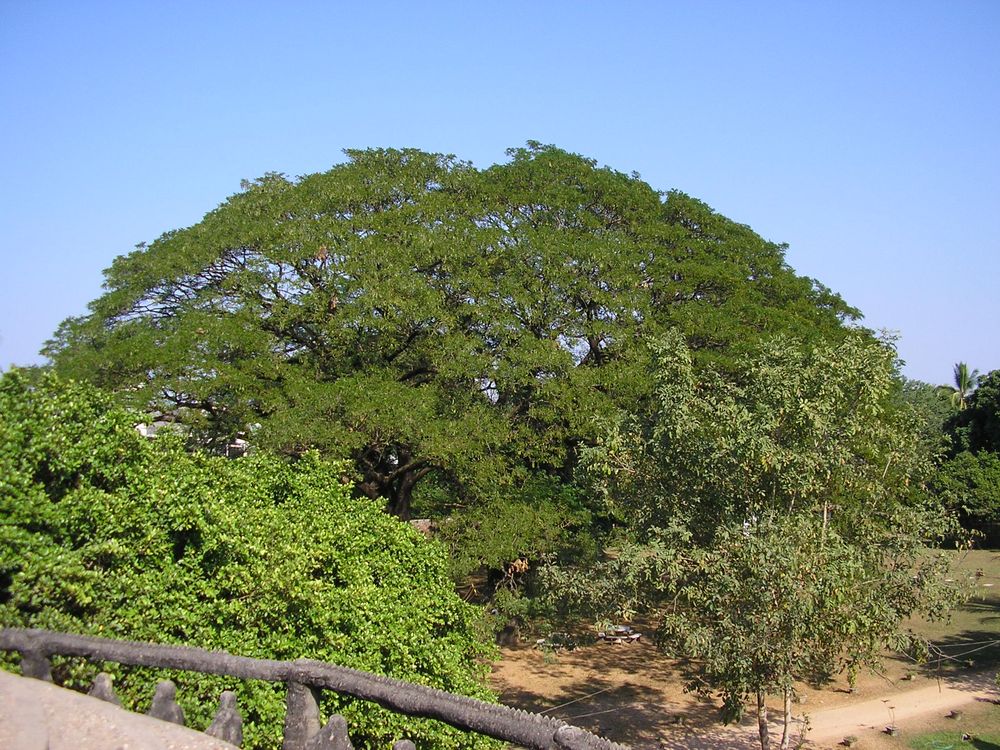
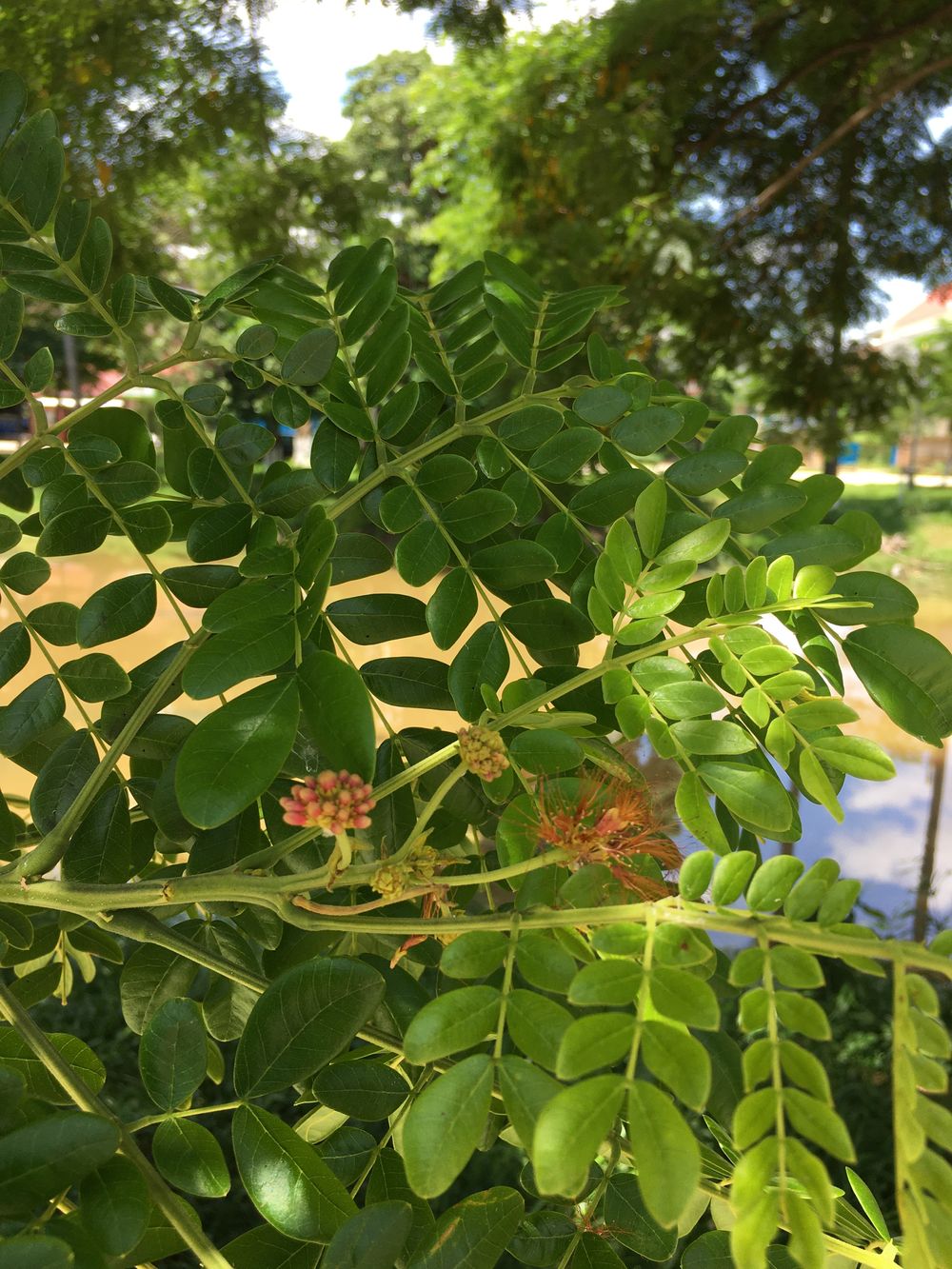
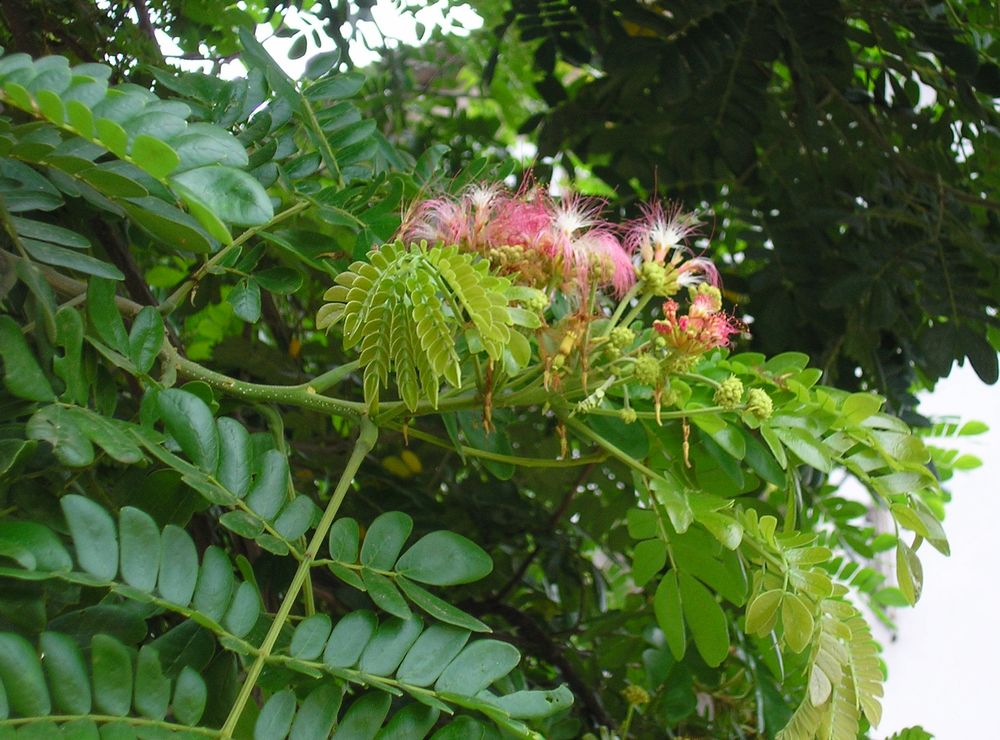
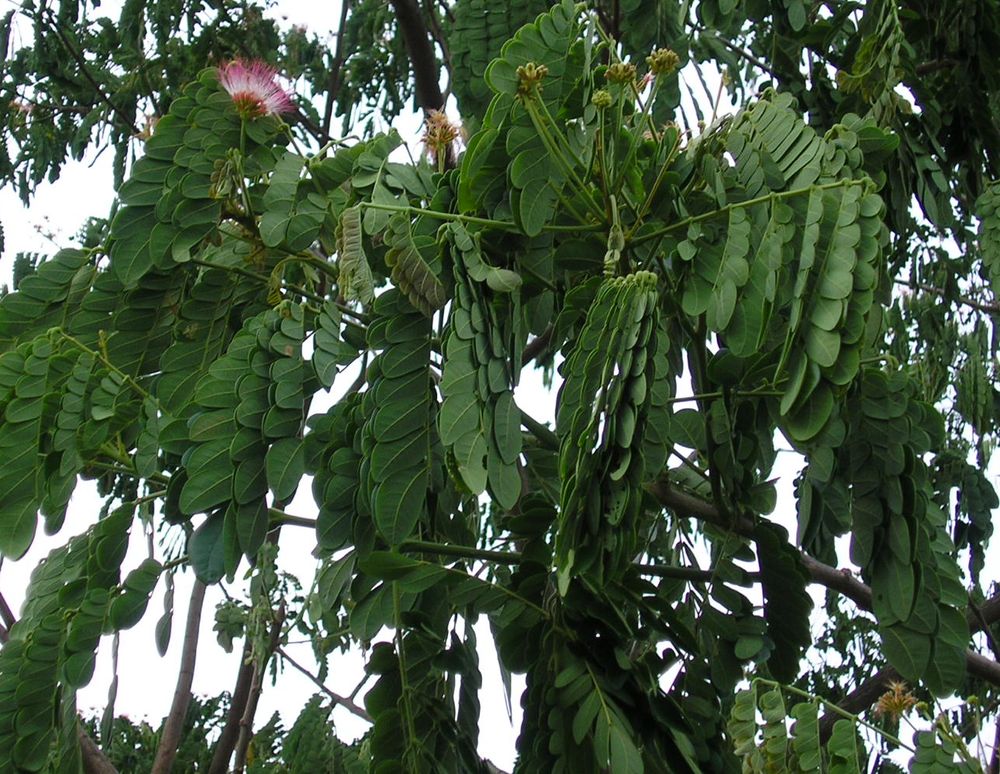
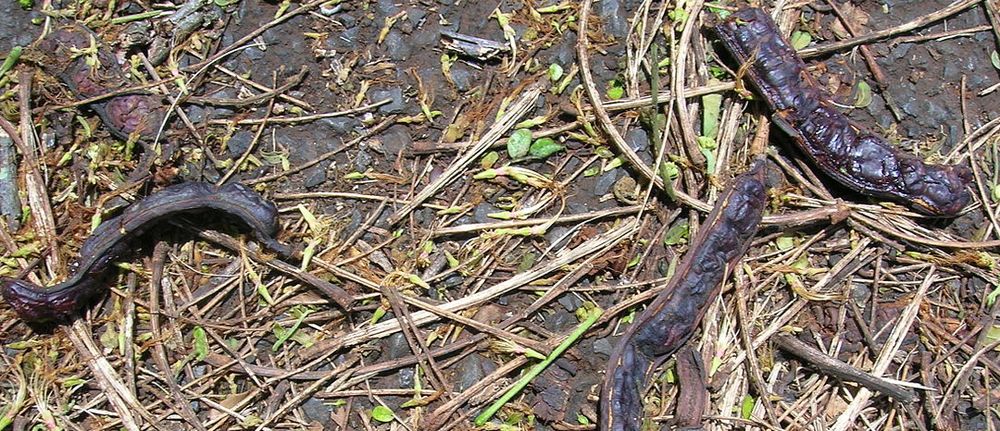
A number of Legumes (Fabaceae) have been introduced to Laos for their ornamental value. The Saman, native to South America, was first planted in the region, Petelot tells us, in 1875 at the Saigon Botanical Garden.
It is a very big and very tall tree (up to 50 meters), with a rough and tormented trunk, which gives an impression of strength and power on the banks of the Mekong in Luang Prabang and in the streets of Vientiane where it is not has not yet been knocked down to make way for cars. Its foliage is very dense and its small, reddish flowers unremarkable. It gives elongated, fleshy, blackish pods of about fifteen centimetres. Its leaves have the particularity, like those of several legumes, of folding up at dusk or during heavy rains, which allows the foliage to be protected, but also the grass to grow under the tree.
The sweet pods of the Saman are treats for children, and for monkeys, if we are to believe one of its English names: Monkey Pod. In addition, foliage, flowers and pods are good fodder for animals. In Luang Prabang, the pods are made into a good infusion for sore mouths.
However, the main interest of the Saman, with its shade, is its wood which is beautiful and of good quality, it is made into elegant and solid furniture and boats.
Finally, we are not surprised to hear it said, in Luang Prabang, that a tree of such presence is considered protective.
Un certain nombre de Légumineuses (Fabaceae) ont été introduites au Laos pour leur valeur ornementale. Le Saman, originaire d’Amérique du Sud, a été planté pour la première fois dans la région, nous dit Petelot, en 1875 au jardin botanique de Saigon.
C’est un très gros et très grand arbre (jusqu’à 50 mètres), au tronc rugueux et tourmenté, qui donne une impression de force et de puissance au bord du Mékong à Louang Prabang et dans les rues de Vientiane où il n’a pas encore été abattu pour laisser la place aux voitures. Son feuillage est très dense et ses fleurs petites et rougeâtres peu remarquables. Il donne des gousses allongées, charnues, noirâtres d’une quinzaine de centimètres. Ses feuilles ont la particularité, comme celles de plusieurs légumineuses, de se replier au crépuscule ou lors de fortes pluies, ce qui permet au feuillage d’être protégé, mais aussi à l’herbe de pousser sous l’arbre.
Les gousses sucrées du Saman sont des friandises pour les enfants, et pour les singes, si l’on en croit l’un de ses noms anglais : Monkey Pod. Par ailleurs, feuillage, fleurs et gousses constituent un bon fourrage pour les animaux. A Louang Prabang on ferait avec les gousses une infusion bonne pour les maux de bouche.
Cependant, l’intérêt principal du Saman, avec son ombrage, c’est son bois qui est beau et de bonne qualité, on en fait des meubles élégants et solides et des bateaux.
Enfin nous ne sommes pas étonnées d’entendre dire, à Louang Prabang, qu’un arbre d’une telle prestance est considéré comme protecteur.










A number of Legumes (Fabaceae) have been introduced to Laos for their ornamental value. The Saman, native to South America, was first planted in the region, Petelot tells us, in 1875 at the Saigon Botanical Garden.
It is a very big and very tall tree (up to 50 meters), with a rough and tormented trunk, which gives an impression of strength and power on the banks of the Mekong in Luang Prabang and in the streets of Vientiane where it is not has not yet been knocked down to make way for cars. Its foliage is very dense and its small, reddish flowers unremarkable. It gives elongated, fleshy, blackish pods of about fifteen centimetres. Its leaves have the particularity, like those of several legumes, of folding up at dusk or during heavy rains, which allows the foliage to be protected, but also the grass to grow under the tree.
The sweet pods of the Saman are treats for children, and for monkeys, if we are to believe one of its English names: Monkey Pod. In addition, foliage, flowers and pods are good fodder for animals. In Luang Prabang, the pods are made into a good infusion for sore mouths.
However, the main interest of the Saman, with its shade, is its wood which is beautiful and of good quality, it is made into elegant and solid furniture and boats.
Finally, we are not surprised to hear it said, in Luang Prabang, that a tree of such presence is considered protective.
Un certain nombre de Légumineuses (Fabaceae) ont été introduites au Laos pour leur valeur ornementale. Le Saman, originaire d’Amérique du Sud, a été planté pour la première fois dans la région, nous dit Petelot, en 1875 au jardin botanique de Saigon.
C’est un très gros et très grand arbre (jusqu’à 50 mètres), au tronc rugueux et tourmenté, qui donne une impression de force et de puissance au bord du Mékong à Louang Prabang et dans les rues de Vientiane où il n’a pas encore été abattu pour laisser la place aux voitures. Son feuillage est très dense et ses fleurs petites et rougeâtres peu remarquables. Il donne des gousses allongées, charnues, noirâtres d’une quinzaine de centimètres. Ses feuilles ont la particularité, comme celles de plusieurs légumineuses, de se replier au crépuscule ou lors de fortes pluies, ce qui permet au feuillage d’être protégé, mais aussi à l’herbe de pousser sous l’arbre.
Les gousses sucrées du Saman sont des friandises pour les enfants, et pour les singes, si l’on en croit l’un de ses noms anglais : Monkey Pod. Par ailleurs, feuillage, fleurs et gousses constituent un bon fourrage pour les animaux. A Louang Prabang on ferait avec les gousses une infusion bonne pour les maux de bouche.
Cependant, l’intérêt principal du Saman, avec son ombrage, c’est son bois qui est beau et de bonne qualité, on en fait des meubles élégants et solides et des bateaux.
Enfin nous ne sommes pas étonnées d’entendre dire, à Louang Prabang, qu’un arbre d’une telle prestance est considéré comme protecteur.


